Exploring the Diverse Response of Cropland Vegetation to Climatic Factors and Irrigation across China
Abstract
1. Introduction
2. Materials and Methods
2.1. Study Area
2.2. Data Sources and Preprocessing
2.3. Data Analysis
2.3.1. Potential Evapotranspiration
2.3.2. Partial Correlation Analysis
2.3.3. Pearson Correlation Coefficient
3. Results
3.1. The Cropland Vegetation Response to Climatic Factors
3.1.1. Response of Cropland Vegetation to Precipitation
3.1.2. Response of Cropland Vegetation to PET
3.1.3. Response of Cropland Vegetation to Water Deficits
3.2. Response of Crop Yield to Irrigation Rate
3.2.1. Relationship between Cropland NDVI and Crop Yields
3.2.2. The Effect of Different Irrigation Rate on Potential Crop Yields
4. Discussion
4.1. Discrepancy Response of Cropland Vegetation to Legacy Effects
4.2. Adaptive Irrigation Practices for Different Grain-Producing Areas
5. Conclusions
Author Contributions
Funding
Data Availability Statement
Acknowledgments
Conflicts of Interest
References
- Chen, N.; Zhang, Y.; Yuan, F.; Song, C.; Xu, M.; Wang, Q.; Hao, G.; Bao, T.; Zuo, Y.; Liu, J.; et al. Warming-Induced Vapor Pressure Deficit Suppression of Vegetation Growth Diminished in Northern Peatlands. Nat. Commun. 2023, 14, 7885. [Google Scholar] [CrossRef] [PubMed]
- Xu, Y.; Dai, Q.-Y.; Zou, B.; Xu, M.; Feng, Y.-X. Tracing Climatic and Human Disturbance in Diverse Vegetation Zones in China: Over 20 Years of NDVI Observations. Ecol. Indic. 2023, 156, 111170. [Google Scholar] [CrossRef]
- Lai, J.; Zhao, T.; Qi, S. Spatiotemporal Variation in Vegetation and Its Driving Mechanisms in the Southwest Alpine Canyon Area of China. Forests 2023, 14, 2357. [Google Scholar] [CrossRef]
- Lian, X.; Jiao, L.; Liu, Z.; Jia, Q.; Zhong, J.; Fang, M.; Wang, W. Multi-Spatiotemporal Heterogeneous Legacy Effects of Climate on Terrestrial Vegetation Dynamics in China. GISci. Remote Sens. 2022, 59, 164–183. [Google Scholar] [CrossRef]
- Duveiller, G.; Hooker, J.; Cescatti, A. The Mark of Vegetation Change on Earth’s Surface Energy Balance. Nat. Commun. 2018, 9, 679. [Google Scholar] [CrossRef]
- Zhou, Y.; Batelaan, O.; Guan, H.; Liu, T.; Duan, L.; Wang, Y.; Li, X. Assessing Long-Term Trends in Vegetation Cover Change in the Xilin River Basin: Potential for Monitoring Grassland Degradation and Restoration. J. Environ. Manag. 2024, 349, 119579. [Google Scholar] [CrossRef]
- Ren, Y.; Zhang, F.; Zhao, C.; Cheng, Z. Attribution of Climate Change and Human Activities to Vegetation NDVI in Jilin Province, China during 1998–2020. Ecol. Indic. 2023, 153, 110415. [Google Scholar] [CrossRef]
- Bhanja, S.N.; Malakar, P.; Mukherjee, A.; Rodell, M.; Mitra, P.; Sarkar, S. Using Satellite-Based Vegetation Cover as Indicator of Groundwater Storage in Natural Vegetation Areas. Geophys. Res. Lett. 2019, 46, 8082–8092. [Google Scholar] [CrossRef]
- Li, W.; Zhou, J.; Xu, Z.; Liang, Y.; Shi, J.; Zhao, X. Climate Impact Greater on Vegetation NPP but Human Enhance Benefits after the Grain for Green Program in Loess Plateau. Ecol. Indic. 2023, 157, 111201. [Google Scholar] [CrossRef]
- Fan, F.; Xiao, C.; Feng, Z.; Yang, Y. Impact of Human and Climate Factors on Vegetation Changes in Mainland Southeast Asia and Yunnan Province of China. J. Clean. Prod. 2023, 415, 137690. [Google Scholar] [CrossRef]
- Pearson, R.G.; Phillips, S.J.; Loranty, M.M.; Beck, P.S.A.; Damoulas, T.; Knight, S.J.; Goetz, S.J. Shifts in Arctic Vegetation and Associated Feedbacks under Climate Change. Nat. Clim. Chang. 2013, 3, 673–677. [Google Scholar] [CrossRef]
- Liu, H.; Deng, Y.; Liu, X. The Contribution of Forest and Grassland Change Was Greater than That of Cropland in Human-Induced Vegetation Greening in China, Especially in Regions with High Climate Variability. Sci. Total Environ. 2021, 792, 148408. [Google Scholar] [CrossRef] [PubMed]
- Yang, S.; Liu, J.; Wang, C.; Zhang, T.; Dong, X.; Liu, Y. Vegetation Dynamics Influenced by Climate Change and Human Activities in the Hanjiang River Basin, Central China. Ecol. Indic. 2022, 145, 109586. [Google Scholar] [CrossRef]
- Zhang, Y.; Lu, Y.; Song, X. Identifying the Main Factors Influencing Significant Global Vegetation Changes. Forests 2023, 14, 1607. [Google Scholar] [CrossRef]
- Ren, H.; Chen, C.; Li, Y.; Zhu, W.; Zhang, L.; Wang, L.; Zhu, L. Response of Vegetation Coverage to Climate Changes in the Qinling-Daba Mountains of China. Forests 2023, 14, 425. [Google Scholar] [CrossRef]
- Hu, B.; Xie, M.; He, R.; Shi, Z.; Zhou, Y.; Ni, H.; Li, H. Spatio-Temporal Evolution of Cropland Ecosystem Services Value and Its Spatially Varying Dominate over the Past Two Decades: A Case Study in Jiangxi Province in Southern China. J. Clean. Prod. 2023, 427, 139228. [Google Scholar] [CrossRef]
- Chen, W.; Yang, L.; Zeng, J.; Yuan, J.; Gu, T.; Liu, Z. Untangling the Increasing Elevation of Cropland in China from 1980 to 2020. Geogr. Sustain. 2023, 4, 281–293. [Google Scholar] [CrossRef]
- Zhang, M.; Li, G.; He, T.; Zhai, G.; Guo, A.; Chen, H.; Wu, C. Reveal the Severe Spatial and Temporal Patterns of Abandoned Cropland in China over the Past 30 Years. Sci. Total Environ. 2023, 857, 159591. [Google Scholar] [CrossRef]
- Kuttippurath, J.; Kashyap, R. Greening of India: Forests or Croplands? Appl. Geogr. 2023, 161, 103115. [Google Scholar] [CrossRef]
- Hu, B.; Xie, M.; Li, H.; He, R.; Zhou, Y.; Jiang, Y.; Ji, W.; Peng, J.; Xia, F.; Liang, Z.; et al. Climate and Soil Management Factors Control Spatio-Temporal Variation of Soil Nutrients and Soil Organic Matter in the Farmland of Jiangxi Province in South China. J. Soils Sediments 2023, 23, 2373–2395. [Google Scholar] [CrossRef]
- Xiao, Y.; Xie, G.; Lu, C.; Ding, X.; Lu, Y. The Value of Gas Exchange as a Service by Rice Paddies in Suburban Shanghai, PR China. Agric. Ecosyst. Environ. 2005, 109, 273–283. [Google Scholar] [CrossRef]
- Yu, S.; Wang, L.; Zhao, J.; Shi, Z. Using Structural Equation Modelling to Identify Regional Socio-Economic Driving Forces of Soil Erosion: A Case Study of Jiangxi Province, Southern China. J. Environ. Manag. 2021, 279, 111616. [Google Scholar] [CrossRef] [PubMed]
- Wuyun, D.; Sun, L.; Chen, Z.; Hou, A.; Crusiol, L.G.T.; Yu, L.; Chen, R.; Sun, Z. The Spatiotemporal Change of Cropland and Its Impact on Vegetation Dynamics in the Farming-Pastoral Ecotone of Northern China. Sci. Total Environ. 2022, 805, 150286. [Google Scholar] [CrossRef] [PubMed]
- Subedi, Y.R.; Kristiansen, P.; Cacho, O. Reutilising Abandoned Cropland in the Hill Agroecological Region of Nepal: Options and Farmers’ Preferences. Land Use Policy 2022, 117, 106082. [Google Scholar] [CrossRef]
- Song, W.; Song, W. Cropland Fallow Reduces Agricultural Water Consumption by 303 Million Tons Annually in Gansu Province, China. Sci. Total Environ. 2023, 879, 163013. [Google Scholar] [CrossRef]
- Wang, X.; Lu, C.; Fang, J.; Shen, Y. Implications for Development of Grain-for-Green Policy Based on Cropland Suitability Evaluation in Desertification-Affected north China. Land Use Policy 2007, 24, 417–424. [Google Scholar] [CrossRef]
- Xue, J.; Zhang, X.-L.; Chen, S.-C.; Hu, B.-F.; Wang, N.; Shi, Z. Quantifying the Agreement and Accuracy Characteristics of Four Satellite-Based LULC Products for Cropland Classification in China. J. Integr. Agric. 2024, 23, 283–297. [Google Scholar] [CrossRef]
- Matas-Granados, L.; Pizarro, M.; Cayuela, L.; Domingo, D.; Gómez, D.; García, M.B. Long-Term Monitoring of NDVI Changes by Remote Sensing to Assess the Vulnerability of Threatened Plants. Biol. Conserv. 2022, 265, 109428. [Google Scholar] [CrossRef]
- Eisfelder, C.; Asam, S.; Hirner, A.; Reiners, P.; Holzwarth, S.; Bachmann, M.; Gessner, U.; Dietz, A.; Huth, J.; Bachofer, F.; et al. Seasonal Vegetation Trends for Europe over 30 Years from a Novel Normalised Difference Vegetation Index (NDVI) Time-Series—The TIMELINE NDVI Product. Remote Sens. 2023, 15, 3616. [Google Scholar] [CrossRef]
- Son, N.T.; Chen, C.F.; Chen, C.R.; Minh, V.Q.; Trung, N.H. A Comparative Analysis of Multitemporal MODIS EVI and NDVI Data for Large-Scale Rice Yield Estimation. Agric. For. Meteorol. 2014, 197, 52–64. [Google Scholar] [CrossRef]
- Peng, J.; Liu, Z.; Liu, Y.; Wu, J.; Han, Y. Trend Analysis of Vegetation Dynamics in Qinghai–Tibet Plateau Using Hurst Exponent. Ecol. Indic. 2012, 14, 28–39. [Google Scholar] [CrossRef]
- Ding, Y.; He, X.; Zhou, Z.; Hu, J.; Cai, H.; Wang, X.; Li, L.; Xu, J.; Shi, H. Response of Vegetation to Drought and Yield Monitoring Based on NDVI and SIF. CATENA 2022, 219, 106328. [Google Scholar] [CrossRef]
- Wang, X.; Yan, S.; Wang, W.; Yin, L.; Li, M.; Yu, Z.; Chang, S.; Hou, F. Monitoring Leaf Area Index of the Sown Mixture Pasture through UAV Multispectral Image and Texture Characteristics. Comput. Electron. Agric. 2023, 214, 108333. [Google Scholar] [CrossRef]
- Shammi, S.A.; Meng, Q. Use Time Series NDVI and EVI to Develop Dynamic Crop Growth Metrics for Yield Modeling. Ecol. Indic. 2021, 121, 107124. [Google Scholar] [CrossRef]
- Li, M.; Cao, S.; Zhu, Z.; Wang, Z.; Myneni, R.B.; Piao, S. Spatiotemporally Consistent Global Dataset of the GIMMS Normalized Difference Vegetation Index (PKU GIMMS NDVI) from 1982 to 2022. Earth Syst. Sci. Data 2023, 15, 4181–4203. [Google Scholar] [CrossRef]
- Ma, C.; Li, T.; Liu, P. GIMMS NDVI3g+ (1982–2015) Response to Climate Change and Engineering Activities along the Qinghai–Tibet Railway. Ecol. Indic. 2021, 128, 107821. [Google Scholar] [CrossRef]
- Liu, Y.; Li, L.; Chen, X.; Zhang, R.; Yang, J. Temporal-Spatial Variations and Influencing Factors of Vegetation Cover in Xinjiang from 1982 to 2013 Based on GIMMS-NDVI3g. Glob. Planet. Chang. 2018, 169, 145–155. [Google Scholar] [CrossRef]
- Gao, W.; Zheng, C.; Liu, X.; Lu, Y.; Chen, Y.; Wei, Y.; Ma, Y. NDVI-Based Vegetation Dynamics and Their Responses to Climate Change and Human Activities from 1982 to 2020: A Case Study in the Mu Us Sandy Land, China. Ecol. Indic. 2022, 137, 108745. [Google Scholar] [CrossRef]
- Gong, H.; Cheng, Q.; Jin, H.; Ren, Y. Effects of Temporal, Spatial, and Elevational Variation in Bioclimatic Indices on the NDVI of Different Vegetation Types in Southwest China. Ecol. Indic. 2023, 154, 110499. [Google Scholar] [CrossRef]
- Snyder, K.A.; Tartowski, S.L. Multi-Scale Temporal Variation in Water Availability: Implications for Vegetation Dynamics in Arid and Semi-Arid Ecosystems. J. Arid Environ. 2006, 65, 219–234. [Google Scholar] [CrossRef]
- Guo, F.; Liu, D.; Mo, S.; Huang, Q.; Ma, L.; Xie, S.; Deng, W.; Ming, G.; Fan, J. Estimation of Daily Evapotranspiration in Gully Area Scrub Ecosystems on Loess Plateau of China Based on Multisource Observation Data. Ecol. Indic. 2023, 154, 110671. [Google Scholar] [CrossRef]
- Wang, F.; Liang, W.; Fu, B.; Jin, Z.; Yan, J.; Zhang, W.; Fu, S.; Yan, N. Changes of Cropland Evapotranspiration and Its Driving Factors on the Loess Plateau of China. Sci. Total Environ. 2020, 728, 138582. [Google Scholar] [CrossRef]
- Da Silva, J.B.A.; de Almeida, G.L.P.; da Silva, M.V.; de Oliveira-Junior, J.F.; Pandorfi, H.; de Sousa, A.M.O.; Marinho, G.T.B.; Giongo, P.R.; Ferreira, M.B.; de Sousa, J.S.; et al. Characterization of Water Status and Vegetation Cover Change in a Watershed in Northeastern Brazil. J. S. Am. Earth Sci. 2023, 130, 104546. [Google Scholar] [CrossRef]
- Piao, S.; Fang, J.; Zhou, L.; Guo, Q.; Henderson, M.; Ji, W.; Li, Y.; Tao, S. Interannual Variations of Monthly and Seasonal Normalized Difference Vegetation Index (NDVI) in China from 1982 to 1999. J. Geophys. Res. Atmos. 2003, 108, 4401. [Google Scholar] [CrossRef]
- Wen, Y.; Liu, X.; Yang, J.; Lin, K.; Du, G. NDVI Indicated Inter-Seasonal Non-Uniform Time-Lag Responses of Terrestrial Vegetation Growth to Daily Maximum and Minimum Temperature. Glob. Planet. Chang. 2019, 177, 27–38. [Google Scholar] [CrossRef]
- Qi, X.; Feng, K.; Sun, L.; Zhao, D.; Huang, X.; Zhang, D.; Liu, Z.; Baiocchi, G. Rising Agricultural Water Scarcity in China Is Driven by Expansion of Irrigated Cropland in Water Scarce Regions. One Earth 2022, 5, 1139–1152. [Google Scholar] [CrossRef]
- Gonçalves, L.R.; Oliveira, C.W.; Meireles, A.C.M. Spatial Distribution of Evapotranspiration by Fractional Vegetation Cover Index on Irrigated Cropland Banana (Musa spp.) in the Semiarid. Remote Sens. Appl. Soc. Environ. 2023, 29, 100878. [Google Scholar] [CrossRef]
- Qiu, J.; Zipper, S.C.; Motew, M.; Booth, E.G.; Kucharik, C.J.; Loheide, S.P. Nonlinear Groundwater Influence on Biophysical Indicators of Ecosystem Services. Nat. Sustain. 2019, 2, 475–483. [Google Scholar] [CrossRef]
- Flörke, M.; Schneider, C.; McDonald, R.I. Water Competition between Cities and Agriculture Driven by Climate Change and Urban Growth. Nat. Sustain. 2018, 1, 51–58. [Google Scholar] [CrossRef]
- Marchionni, V.; Fatichi, S.; Tapper, N.; Walker, J.P.; Manoli, G.; Daly, E. Assessing Vegetation Response to Irrigation Strategies and Soil Properties in an Urban Reserve in Southeast Australia. Landsc. Urban Plan. 2021, 215, 104198. [Google Scholar] [CrossRef]
- Ma, R.; Shen, X.; Zhang, J.; Xia, C.; Liu, Y.; Wu, L.; Wang, Y.; Jiang, M.; Lu, X. Variation of Vegetation Autumn Phenology and Its Climatic Drivers in Temperate Grasslands of China. Int. J. Appl. Earth Obs. Geoinf. 2022, 114, 103064. [Google Scholar] [CrossRef]
- Li, C.; Chen, J.; Wu, X.; Zhou, M.; Wei, Y.; Liu, Y.; Liu, L.; Peng, L.; Dou, T.; Li, L. Persistent Effects of Global Warming on Vegetation Growth Are Regulated by Water in China during 2001–2017. J. Clean. Prod. 2022, 381, 135198. [Google Scholar] [CrossRef]
- Ge, C.; Sun, S.; Yao, R.; Sun, P.; Li, M.; Bian, Y. Long-Term Vegetation Phenology Changes and Response to Multi-Scale Meteorological Drought on the Loess Plateau, China. J. Hydrol. 2022, 614, 128605. [Google Scholar] [CrossRef]
- Zhang, Y.; He, Y.; Li, Y.; Jia, L. Spatiotemporal Variation and Driving Forces of NDVI from 1982 to 2015 in the Qinba Mountains, China. Environ. Sci. Pollut. Res. 2022, 29, 52277–52288. [Google Scholar] [CrossRef]
- Xue, S.-Y.; Xu, H.-Y.; Mu, C.-C.; Wu, T.-H.; Li, W.-P.; Zhang, W.-X.; Streletskaya, I.; Grebenets, V.; Sokratov, S.; Kizyakov, A.; et al. Changes in Different Land Cover Areas and NDVI Values in Northern Latitudes from 1982 to 2015. Adv. Clim. Chang. Res. 2021, 12, 456–465. [Google Scholar] [CrossRef]
- Gong, G.; Mattevada, S.; O’bryant, S.E. Comparison of the Accuracy of Kriging and IDW Interpolations in Estimating Groundwater Arsenic Concentrations in Texas. Environ. Res. 2014, 130, 59–69. [Google Scholar] [CrossRef]
- Allen, R.G.; Kilic, A.; D’Urso, G.; Consoli, S. The Penman-Monteith Equation. In Encyclopedia of Soils in the Environment, 2nd ed.; Goss, M.J., Oliver, M., Eds.; Academic Press: Oxford, UK, 2023; pp. 634–645. ISBN 978-0-323-95133-3. [Google Scholar]
- Li, Y.; Qin, Y.; Rong, P. Evolution of Potential Evapotranspiration and Its Sensitivity to Climate Change Based on the Thornthwaite, Hargreaves, and Penman–Monteith Equation in Environmental Sensitive Areas of China. Atmos. Res. 2022, 273, 106178. [Google Scholar] [CrossRef]
- Bai, Y.; Gao, J. Optimization of the Nitrogen Fertilizer Schedule of Maize under Drip Irrigation in Jilin, China, Based on DSSAT and GA. Agric. Water Manag. 2021, 244, 106555. [Google Scholar] [CrossRef]
- Zhao, N.; Zhang, X.; Hu, L.; Liu, H.; Ma, L.; Xu, T.; Han, X.; Kang, S.; Wang, X.; Zhao, X.; et al. Cropping practices manipulate soil bacterial structure and functions on the Qinghai-Tibet Plateau. J. Plant Physiol. 2022, 271, 153666. [Google Scholar] [CrossRef]
- Mo, K.; Chen, Q.; Chen, C.; Zhang, J.; Wang, L.; Bao, Z. Spatiotemporal Variation of Correlation between Vegetation Cover and Precipitation in an Arid Mountain-Oasis River Basin in Northwest China. J. Hydrol. 2019, 574, 138–147. [Google Scholar] [CrossRef]
- Georganos, S.; Abdi, A.M.; Tenenbaum, D.E.; Kalogirou, S. Examining the NDVI-Rainfall Relationship in the Semi-Arid Sahel Using Geographically Weighted Regression. J. Arid Environ. 2017, 146, 64–74. [Google Scholar] [CrossRef]
- Wang, H.; Yan, S.; Liang, Z.; Jiao, K.; Li, D.; Wei, F.; Li, S. Strength of Association between Vegetation Greenness and Its Drivers across China between 1982 and 2015: Regional Differences and Temporal Variations. Ecol. Indic. 2021, 128, 107831. [Google Scholar] [CrossRef]
- Yao, M.; Rui, J.; Niu, H.; Heděnec, P.; Li, J.; He, Z.; Wang, J.; Cao, W.; Li, X. The Differentiation of Soil Bacterial Communities along a Precipitation and Temperature Gradient in the Eastern Inner Mongolia Steppe. CATENA 2017, 152, 47–56. [Google Scholar] [CrossRef]
- Bao, Z.; Zhang, J.; Wang, G.; Guan, T.; Jin, J.; Liu, Y.; Li, M.; Ma, T. The Sensitivity of Vegetation Cover to Climate Change in Multiple Climatic Zones Using Machine Learning Algorithms. Ecol. Indic. 2021, 124, 107443. [Google Scholar] [CrossRef]
- Guo, E.; Yang, X.; Li, T.; Zhang, T.; Wilson, L.T.; Wang, X.; Zheng, D.; Yang, Y. Does ENSO Strongly Affect Rice Yield and Water Application in Northeast China? Agric. Water Manag. 2021, 245, 106605. [Google Scholar] [CrossRef]
- Ding, Y.; Xu, J.; Wang, X.; Cai, H.; Zhou, Z.; Sun, Y.; Shi, H. Propagation of Meteorological to Hydrological Drought for Different Climate Regions in China. J. Environ. Manag. 2021, 283, 111980. [Google Scholar] [CrossRef]
- Tang, Y.; Tang, Q. Variations and Influencing Factors of Potential Evapotranspiration in Large Siberian River Basins during 1975–2014. J. Hydrol. 2021, 598, 126443. [Google Scholar] [CrossRef]
- Hu, X.; Shi, L.; Lin, L.; Zha, Y. Nonlinear Boundaries of Land Surface Temperature–Vegetation Index Space to Estimate Water Deficit Index and Evaporation Fraction. Agric. For. Meteorol. 2019, 279, 107736. [Google Scholar] [CrossRef]
- Ma, Z.; Yan, N.; Wu, B.; Stein, A.; Zhu, W.; Zeng, H. Variation in Actual Evapotranspiration Following Changes in Climate and Vegetation Cover during an Ecological Restoration Period (2000–2015) in the Loess Plateau, China. Sci. Total Environ. 2019, 689, 534–545. [Google Scholar] [CrossRef]
- Joiner, J.; Yoshida, Y.; Anderson, M.; Holmes, T.; Hain, C.; Reichle, R.; Koster, R.; Middleton, E.; Zeng, F.-W. Global Relationships among Traditional Reflectance Vegetation Indices (NDVI and NDII), Evapotranspiration (ET), and Soil Moisture Variability on Weekly Timescales. Remote Sens. Environ. 2018, 219, 339–352. [Google Scholar] [CrossRef]
- Li, Z.; Xiao, Z.-N.; Zheng, C.-W. Observation Analysis of Wind Climate in China for 1971–2017 under the Demand of Wind Energy Evaluation and Utilization. Energy Rep. 2021, 7, 3535–3546. [Google Scholar] [CrossRef]
- Xu, H.-J.; Wang, X.-P.; Zhao, C.-Y.; Yang, X.-M. Diverse Responses of Vegetation Growth to Meteorological Drought across Climate Zones and Land Biomes in Northern China from 1981 to 2014. Agric. For. Meteorol. 2018, 262, 1–13. [Google Scholar] [CrossRef]
- Craine, J.M.; Ocheltree, T.W.; Nippert, J.B.; Towne, E.G.; Skibbe, A.M.; Kembel, S.W.; Fargione, J.E. Global Diversity of Drought Tolerance and Grassland Climate-Change Resilience. Nat. Clim. Chang. 2013, 3, 63–67. [Google Scholar] [CrossRef]
- Zhang, Z.; Li, X.; Liu, L.; Wang, Y.; Li, Y. Influence of Mulched Drip Irrigation on Landscape Scale Evapotranspiration from Farmland in an Arid Area. Agric. Water Manag. 2020, 230, 105953. [Google Scholar] [CrossRef]
- Çelik, Ö.; Ayan, A.; Meriç, S.; Atak, Ç. Comparison of Tolerance Related Proteomic Profiles of Two Drought Tolerant Tomato mutants Improved by Gamma Radiation. J. Biotechnol. 2021, 330, 35–44. [Google Scholar] [CrossRef]
- Zheng, J.; Fan, J.; Zhang, F.; Guo, J.; Yan, S.; Zhuang, Q.; Cui, N.; Guo, L. Interactive effects of mulching practice and nitrogen rate on grain yield, water productivity, fertilizer use efficiency and greenhouse gas emissions of rainfed summer maize in northwest China. Agric. Water Manag. 2021, 248, 106778. [Google Scholar] [CrossRef]
- Maraseni, T.; Kodur, S. Improved prediction of farm nitrous oxide emission through an understanding of the interaction among climate extremes, soil nitrogen dynamics and irrigation water. J. Environ. Manag. 2019, 248, 109278. [Google Scholar] [CrossRef]
- Zhu, Z.; Li, J.; Zhu, D.; Gao, Z. The impact of maize canopy on splash erosion risk on soils with different textures under sprinkler irrigation. CATENA 2024, 234, 10768. [Google Scholar] [CrossRef]
- Kalinitchenko, V.P.; Glinushkin, A.P.; Minkina, T.M.; Mandzhieva, S.S.; Sushkova, S.N.; Sukovatov, V.A.; Il’ina, L.P.; Makarenkov, D.A. Chemical Soil-Biological Engineering Theoretical Foundations, Technical Means, and Technology for Safe Intrasoil Waste Recycling and Long-Term Higher Soil Productivity. ACS Omega 2020, 5, 17553–17564. [Google Scholar] [CrossRef] [PubMed]
- Bunkin, N.F.; Glinushkin, A.P.; Shkirin, A.V.; Ignatenko, D.N.; Chirikov, S.N.; Savchenko, I.V.; Meshalkin, V.P.; Samarin, G.N.; Maleki, A.; Kalinitchenko, V.P. Identification of Organic Matter Dispersions Based on Light Scattering Matrices Focusing on Soil Organic Matter Management. ACS Omega 2020, 5, 33214–33224. [Google Scholar] [CrossRef]

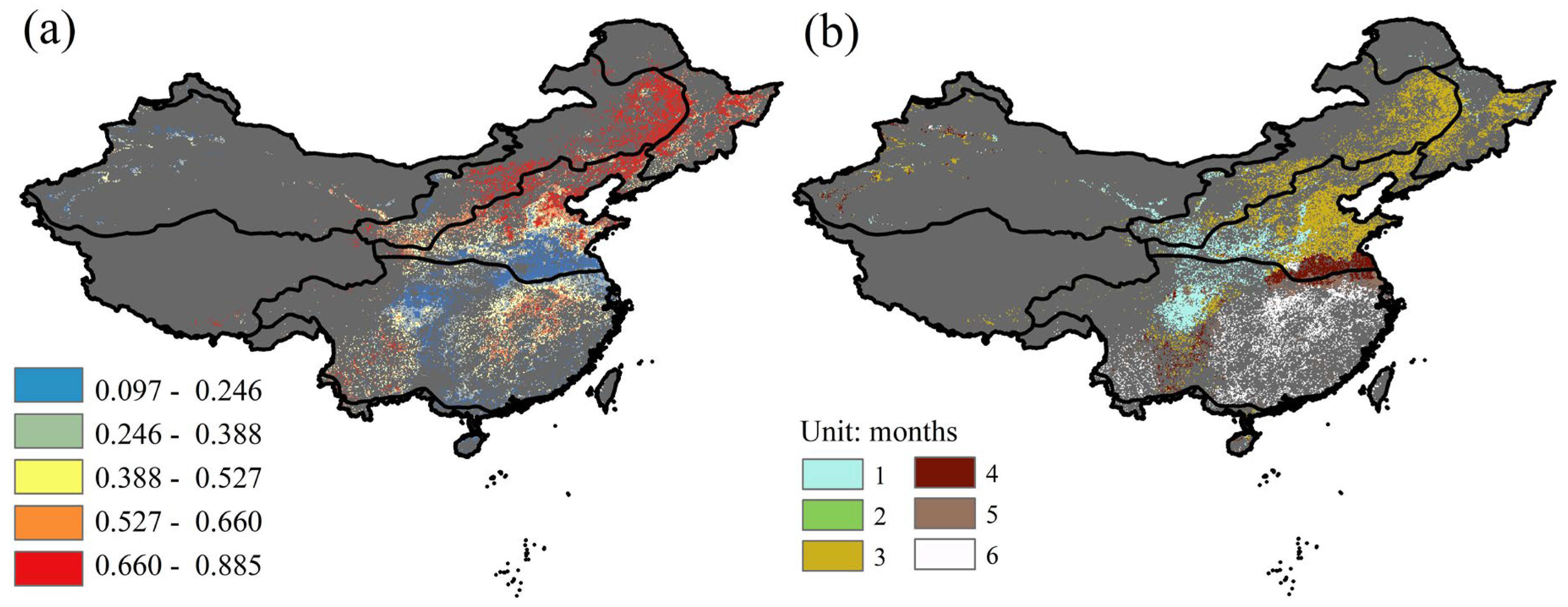
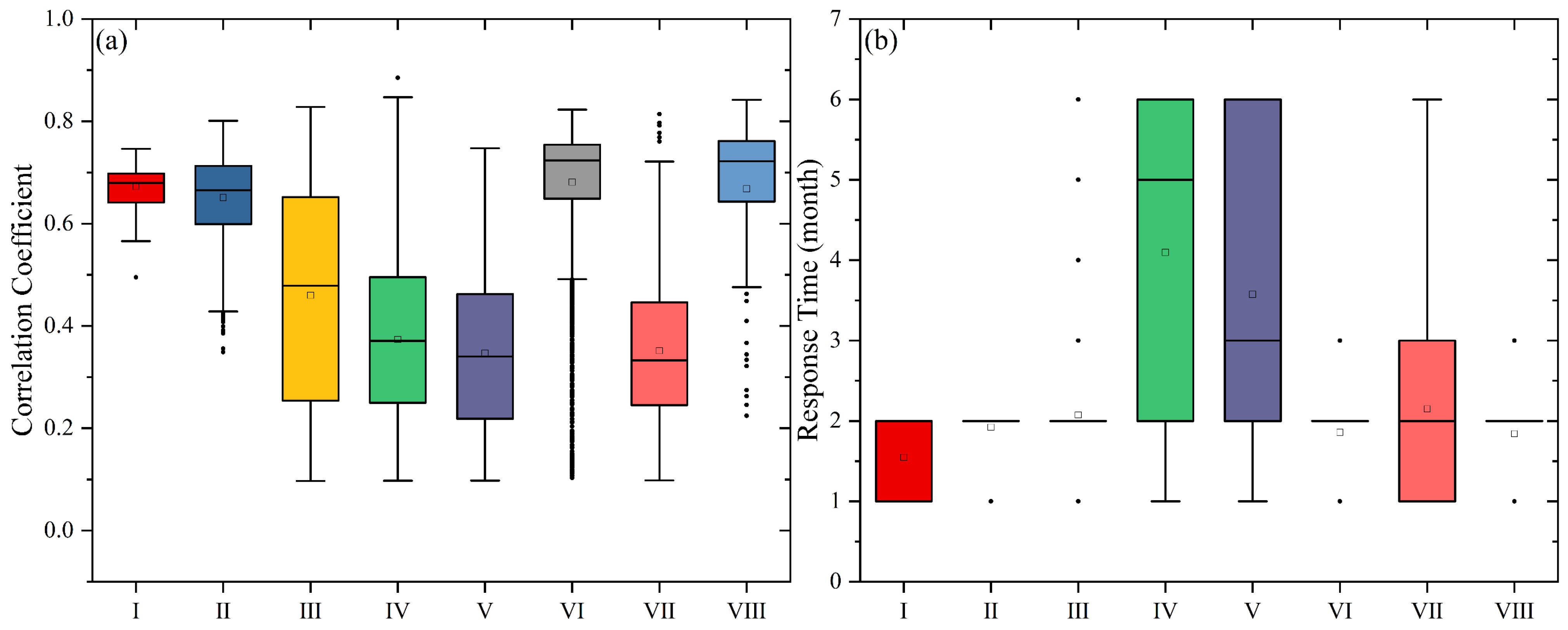
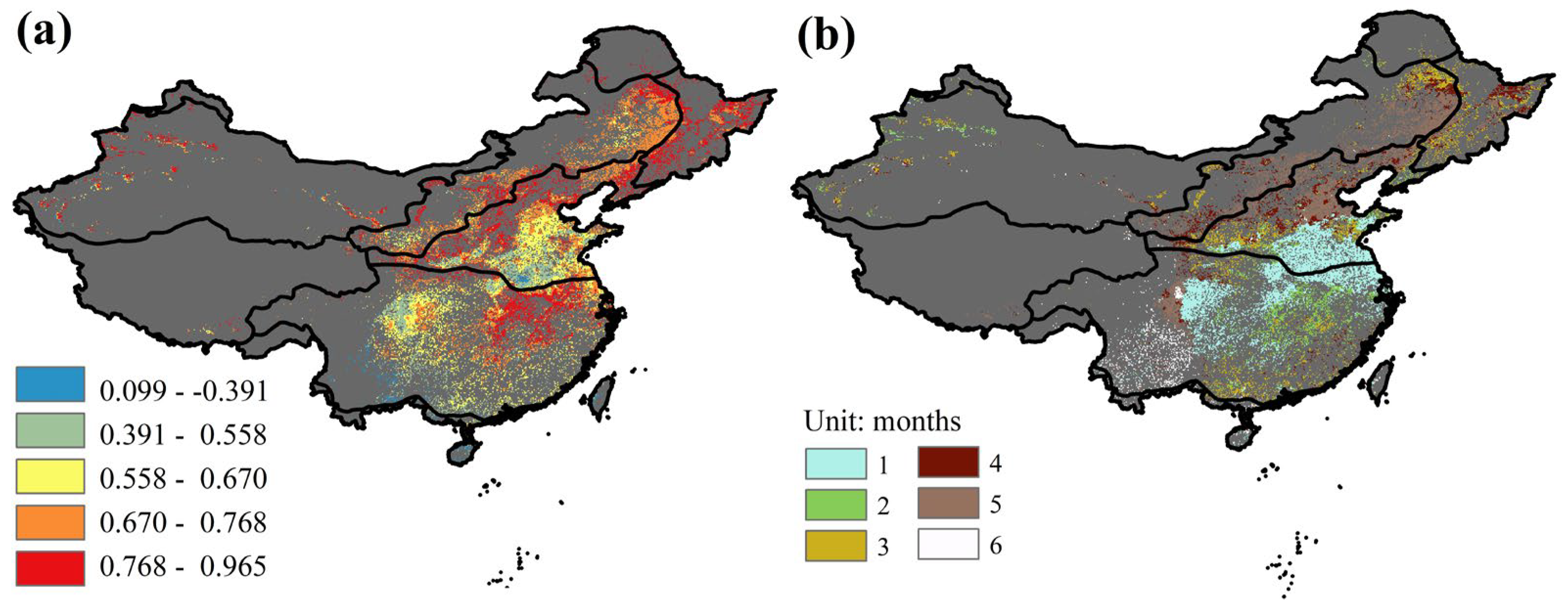
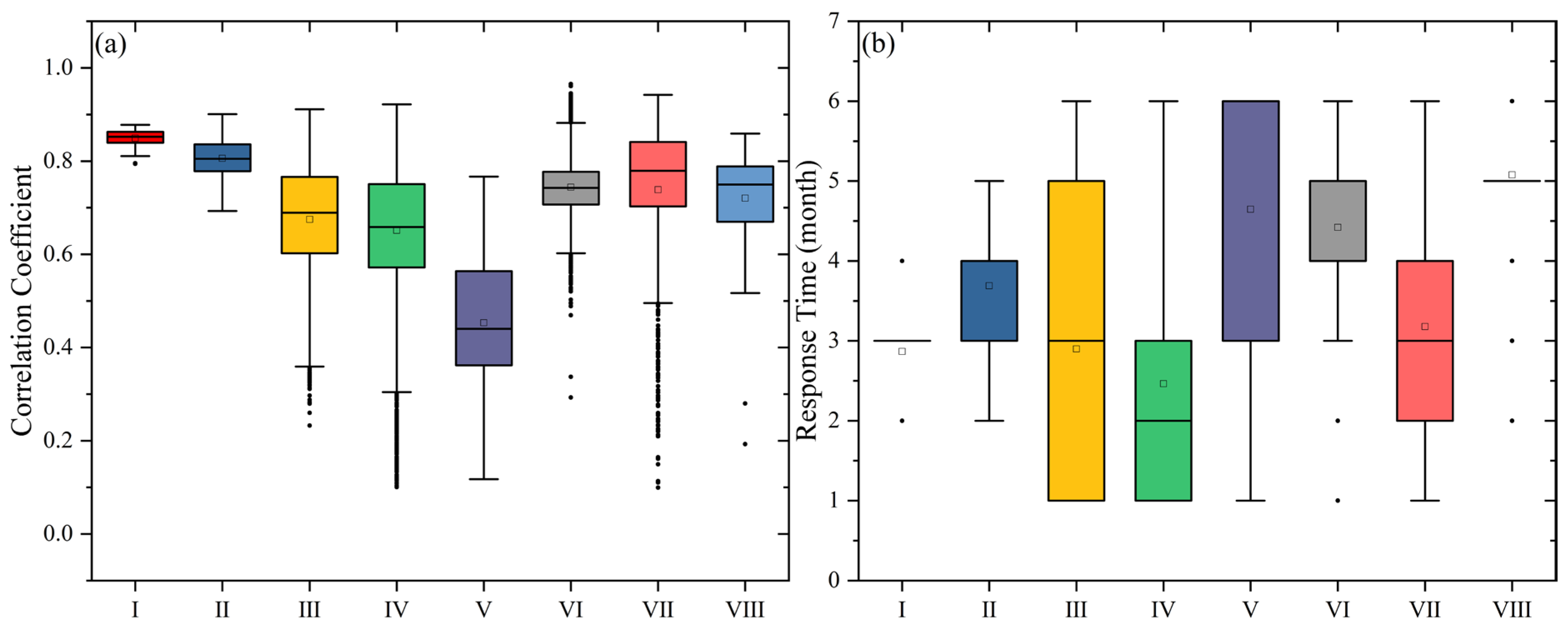
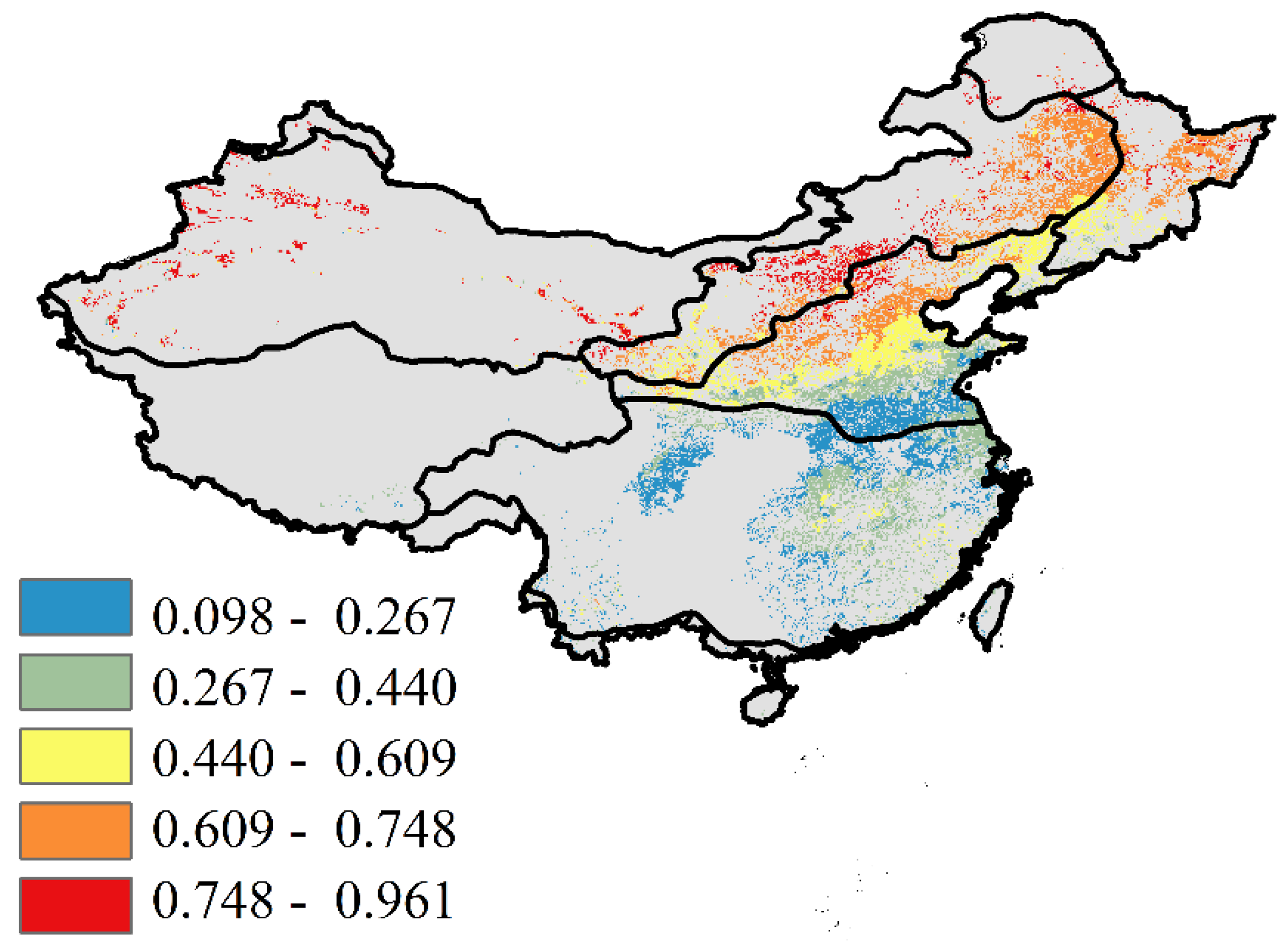
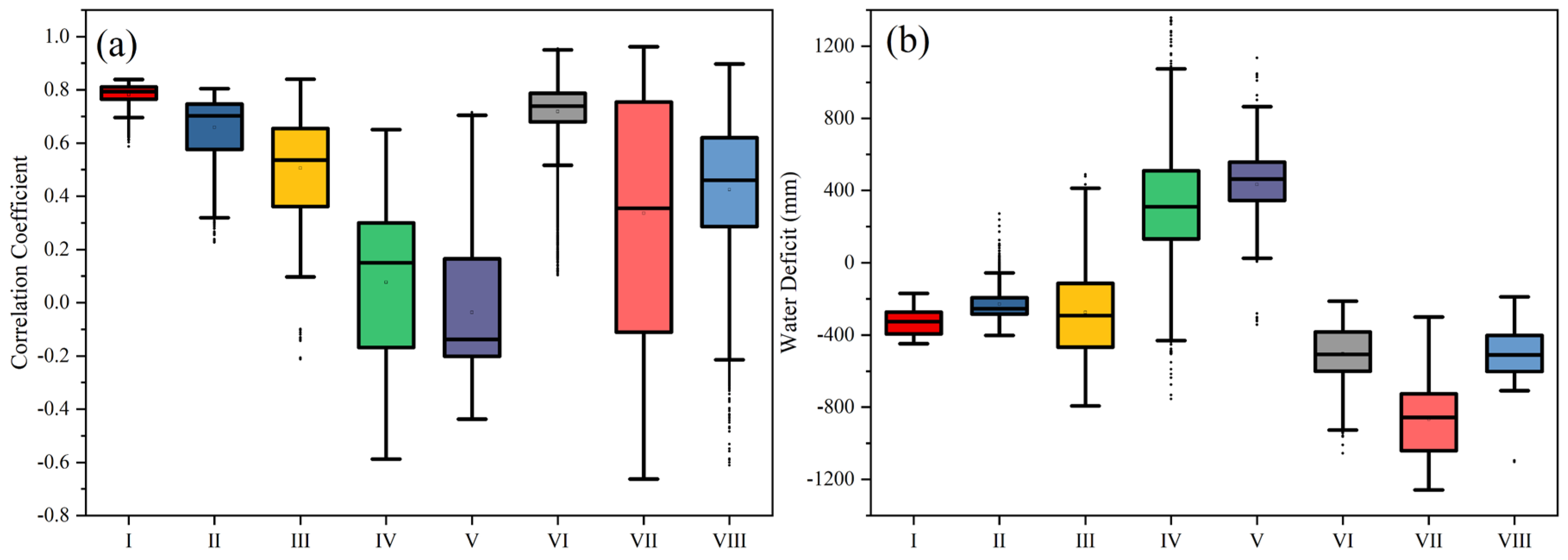


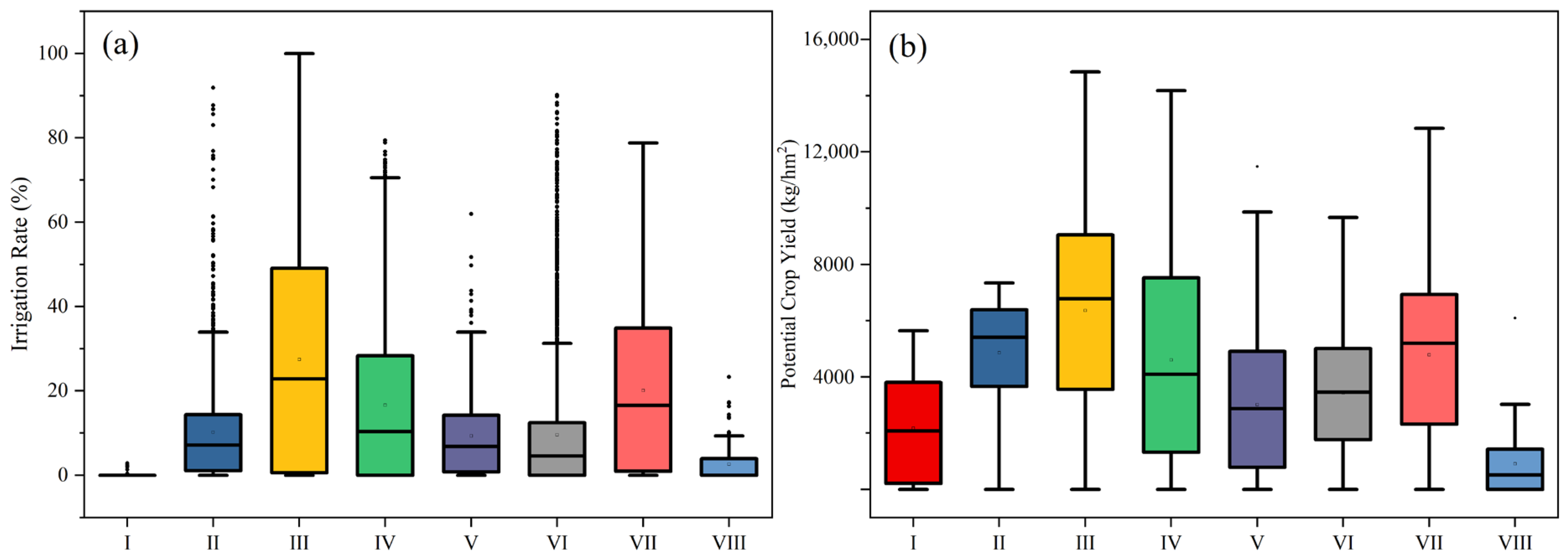
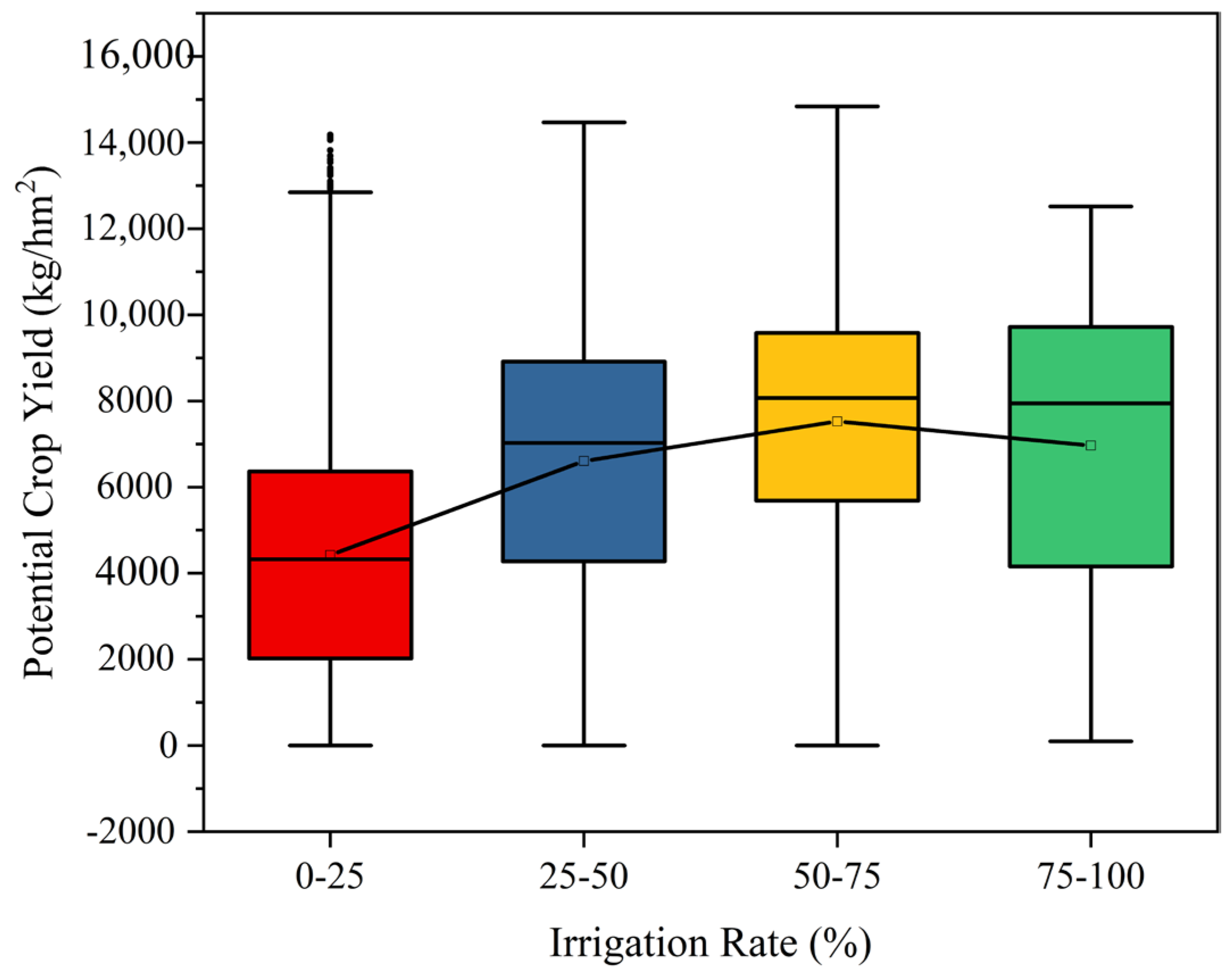


| Climate Zones | Average Annual Potential Evapotranspiration (mm) | Annual Average Cumulative Precipitation (mm) |
|---|---|---|
| I | 269–398 | 464–497 |
| II | 484–555 | 587–735 |
| III | 820–948 | 557–800 |
| IV | 727–998 | 1061–1590 |
| V | 805–1320 | 1567–2052 |
| VI | 677–862 | 340–464 |
| VII | 862–1034 | 104–205 |
| VIII | 655–941 | 340–723 |
Disclaimer/Publisher’s Note: The statements, opinions and data contained in all publications are solely those of the individual author(s) and contributor(s) and not of MDPI and/or the editor(s). MDPI and/or the editor(s) disclaim responsibility for any injury to people or property resulting from any ideas, methods, instructions or products referred to in the content. |
© 2024 by the authors. Licensee MDPI, Basel, Switzerland. This article is an open access article distributed under the terms and conditions of the Creative Commons Attribution (CC BY) license (https://creativecommons.org/licenses/by/4.0/).
Share and Cite
Sun, Y.; Zhong, H.; Ding, Y.; Cai, H.; Peng, X. Exploring the Diverse Response of Cropland Vegetation to Climatic Factors and Irrigation across China. Agronomy 2024, 14, 188. https://doi.org/10.3390/agronomy14010188
Sun Y, Zhong H, Ding Y, Cai H, Peng X. Exploring the Diverse Response of Cropland Vegetation to Climatic Factors and Irrigation across China. Agronomy. 2024; 14(1):188. https://doi.org/10.3390/agronomy14010188
Chicago/Turabian StyleSun, Yanan, Huayu Zhong, Yibo Ding, Huanjie Cai, and Xiongbiao Peng. 2024. "Exploring the Diverse Response of Cropland Vegetation to Climatic Factors and Irrigation across China" Agronomy 14, no. 1: 188. https://doi.org/10.3390/agronomy14010188
APA StyleSun, Y., Zhong, H., Ding, Y., Cai, H., & Peng, X. (2024). Exploring the Diverse Response of Cropland Vegetation to Climatic Factors and Irrigation across China. Agronomy, 14(1), 188. https://doi.org/10.3390/agronomy14010188





